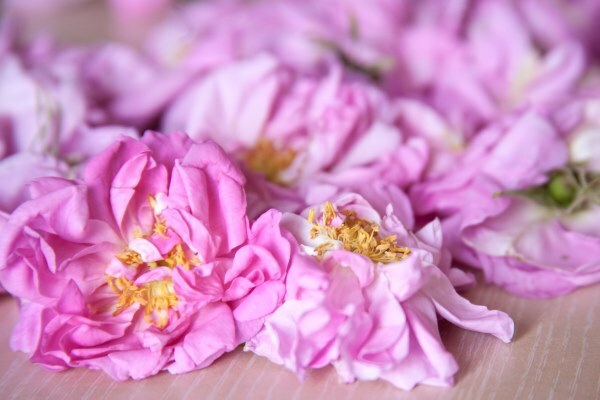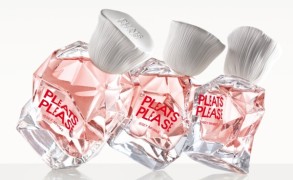Despite the name George Wilson gave to his book, The Complete Course of Chemistry, he was not a chemist by training. Instead, the volume first published in London in 1691 and subsequently reprinted contained an impressive collection of recipes for herbal preparations, elixirs and alchemy experiments. Glancing through this fascinating compilation, I came across a recipe for Sweet Honey Water that Wilson used on King James II. He describes it as having many wondrous effects on one’s well-being, but it was his remark that this water “gives one of the most agreeable scents that can be smelt” that finally caught my attention. Honey, vanilla, coriander, cloves, and musk certainly sound wonderful together, don’t you think?
“Take of good French brandy, a gallon, of the best virgin honey and coriander seeds, each a pound; cloves, an ounce and a half; nutmegs, an ounce; gum benjamin and storax, of each an ounce; benilloes [vanilla beans] number four; the yellow rind of three large lemons. Bruise the cloves, nutmegs, coriander seeds, and benjamin, cut the benilloes into small pieces, put all into a curcurbit (a still), and pour the brandy on to them. After they have digested forty-eight hours, distill off the spirit in Balneo-Mariae [double boiler].
“To a gallon of this water, add of damask rose and orange flower water, of each a pint and a half; of China musk and ambergrise, of each five grains; first grind the musk and ambergrise with some of the water, and afterwards put all into a large matrass (a vessel for digesting and distilling), shake them well together, and let them circulate three days and nights in a gentle heat. Then letting the water cool, filter and keep it for use in a bottle well stopped.
“It is anti-paralytic, smooths the skin and gives one of the most agreeable scents that can be smelt. Forty or sixty drops put into a pint of clear water, are sufficient to wash the hands and face, and with the same proportion to punch or any other cordial-water gives a most pleasant flavor.” From The Complete Course of Chemistry by George Wilson published in London in 1691 (1721 edition).
Image: Honey and Chamomile from 123rfstock images, some rights reserved.

















25 Comments
Maja: sounds wonderful, indeed. could there be a home made version of this? February 15, 2012 at 9:34am
Victoria: Yes, why not, although we might have to do without real musk and ambergris! You don't have to distill it. Just make it as a tincture by mixing the ingredients in brandy. Styrax and benzoin can be found easily online. It reminds me how I make liqueurs–mixing spices and herbs in alcohol and steeping them for several months. I don't have a still either, so I made do without.
Maybe, one of the natural perfumers can offer more suggestions on how to make it at home. February 15, 2012 at 11:20am
skilletlicker: How I miss L’Occitane’s Gentle Honey Water or was it Honey Gentle Water? Some discontinued scents are quite perplexing – I know this one had a loyal fan base. February 15, 2012 at 2:39pm
Andy: This sounds very lovely. I’m certainly no expert, but I think the best way to create such a blend using essential oils and other aromamaterials would be to create a blend of essential oils like coriander, clove, lemon, and benzoin, as well as the essential oils of any other ingredients mentioned in the recipe. West Indies Bay essential oil often has a nice musky, honey-like smell in dilution, so a small amount of that could also be added I suppose. Other diluted synthetics like phenylacetic acid (honey-like), vanillin (vanilla-like), coumarin (hay-like) and musk or ambergris materials would also work well. This concentrated blend would then be diluted into dipropylene glycol (can be found easily from cosmetic suppliers online), and then further diluted into a small amount of alcohol (vodka would work). After that, this mixture could be added to an equal parts mixture of rosewater and orange flower water, put in a spray bottle, and enjoyed. Granted, this method seems somewhat complicated and I don’t have exact quantities in mind, but I think that this would be the best modern day approach to replicating such a blend. Maybe I’ll make something like this soon! 🙂 February 15, 2012 at 3:32pm
Victoria: I don’t remember that one, but I miss L’Occitane Feuille d’Herbe. It had one of the nicest tomato leaf notes. February 15, 2012 at 6:14pm
Victoria: Thank you so much, Andy! I appreciate your feedback, and I would love to hear how this projects goes, if you do decide to try it. The combination of notes alone sounds very interesting. But you are right, everything is in the exact proportions. February 15, 2012 at 6:17pm
Bernadette: This is very interesting! Will try to find a way to make this and let you guys know how it goes. Andy, your tips are very helpful! February 15, 2012 at 6:18pm
Victoria: Please do, Bernadette! It sounds like such a great project, and Andy's advice is so helpful. I have a feeling that if all of us try making this recipe, we will get different scents. It would be lots of fun to compare. February 15, 2012 at 6:26pm
Douglas: The bouquet sounds amazing, with all of those rich spices, though wouldn’t necessarily want this on my skin as described above. Those same spices can also be used to numb and burn. Perhaps there is a safe work-around as the honey could be used to produce a nice moisturizer. Great find V. February 15, 2012 at 8:02pm
Andy: You are welcome, Bernadette, and I agree, V! That would be fun! It is so interesting how each person’s unique aesthetic comes into play with something like scent blending. For me, I imagined this recipe as being a warm, predominantly vanilla and honey fragrance with slight floral touches and a dose of citrus and spice. To another, their idea could be quite different! February 15, 2012 at 8:40pm
breathesgelatin: If I ever go back to grad school, I’d like to work on the intersection of medicine/chemistry/perfume in the 17th and 18th century. My masters thesis in French history dealt with a female apothecary in 18th century Lyon… so much work needs to be done on the ‘eaus’ of that era and their cultural significance… February 15, 2012 at 11:19pm
Victoria: I keep imagining how well honey and coriander might work together. Good point about honey as a moisturizer.
These old recipes can be an interesting starting point! February 16, 2012 at 2:22am
Victoria: That's how I saw it too–with a citrusy rose accord linking honey and spices. And a warm, voluptuous drydown of amber and musk. February 16, 2012 at 2:25am
Victoria: What a great topic! Call me up, if you want a research partner. 🙂
In grad school, I had a professor, who was an authority on medieval history. He also worked on the topic of food and spices in the context of the era. Such a fascinating subject! February 16, 2012 at 2:47am
Amer: Interesting recipe! What is striking as odd is how short the maceration periods are. 48hours? Three days for ambergris? This sounds a bit wasteful… I don’t think you can work around the distillation if you want to use natural honey and I am afraid no substitute works the same scentwise. In general I find tinctures of natural matter (resins, flowers) rarely produce refined scents without distillation. Besides, the alcohol becomes contaminated with sugar and makes skin sticky. February 16, 2012 at 11:46am
Victoria: Yes, that was a bit strange. I at first assumed that it was 48 days.
I usually tincture when I make liqueurs, rather than perfumes. Of course, distillation would make for a much more refined flavor. February 16, 2012 at 1:03pm
Kerrie: Such a fascinating subject! I love to learn about medieval history and anything to do with apothecary/herbs/potions. Thanks Victoria for such a find! February 16, 2012 at 1:16pm
Victoria: It’s my pleasure! I also find this topic fascinating, because perfumery during that era was very closely linked with cuisine, medicine and even alchemy. Fun to imagine that the recipe above could have been used to scent one’s skin and to delight the palate. February 16, 2012 at 4:50pm
Kerrie: Yes, fun to imagine that perfume could be seen as an elixir with a purpose – what an era! February 16, 2012 at 5:47pm
Isis: That’s very interesting! I have a special interest for beauty and cosmetic history, especially the 18th century, and would love to try some of the perfume recipes. I’m not at all sure how wel they would work, though. May 1, 2012 at 10:45am
Victoria: Please let me know what you end up trying. Not all recipes are complicated, but some definitely require a few creative substitutions. May 1, 2012 at 12:43pm
Laura: Fascinating discovery! Good article. May 26, 2012 at 11:40pm
Carolyn: I had Fragrant Honey Water eau de toilette I bought in England about 20 years ago, first from Orchard Apiaries, and then Bannutree House on the internet, does anyone know of a source? It was wonderful! June 2, 2012 at 12:40pm
Rebecca: I’m starting to work with this to make a natural perfume and think I’m going to use an amber accord–labdanum, benzoin, and vanilla as the base. I’m also going make a Co2 extraction of honey, dirty wax, and a tiny bit of propolis.
Thanks for sharing this recipe! March 23, 2021 at 5:21pm
Victoria: Please let me know how it goes! March 24, 2021 at 3:04am